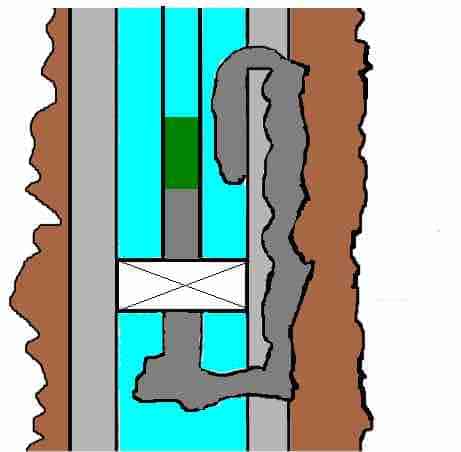More technically, a ‘suicide squeeze’ is an application of a circulating squeeze, used in specific circumstances. In general, the cement squeeze is a fascinating topic, and an important skill to master for any experienced cementer.
In a circulating squeeze, the cement slurry is ‘forced’ to flow through a lower open path and up behind the casing with returns being taken back into the wellbore or to the annulus. Typically, there is an isolation tool, a cement retainer or a packer placed above the lower opening.
Some examples:
a) An attempt to complete casing cementing following incomplete primary cementing. A typical example is the second stage of a failed two-stage cement job. In this case, we place a cement retainer above the stage tool ports (if open) or a perforated interval. We send fluid returns to the surface, and on some occasions, pressure permitting, cement is also returned to the surface;
b) To remediate an impeded liner cementing operation. If a liner top packer is not in place or set, a cement retainer, (the better choice), or a packer is placed somewhere above the landing collar. We keep fluid returns to the top of the liner and cement top within the overlap between casings, or directly above a zone of interest;
c) Another example, (now in remedial cementing), we place a cement retainer or a packer in between two purposely-made perforated intervals with the intention to reinstate zonal isolation in a section of interest behind the casing.
When we use a packer in the example described in (c), the possibility of some costly consequences, catastrophic in nature, are significantly increased (impact + probability = risk). The worst of these consequences being losing the well entirely or a section. More theatrically ‘wasting’ the well, but because we love what we do and constructing the well is what justify our existence, we feel like ‘we are the well’, hence the ‘suicidal’ connotation.
Consequently, this circulating squeeze application in remedial cementing is what is known as a ‘suicide squeeze.’ Why is this a high-risk operation? Or more importantly, why do it?
Now because I am a cementer, answering the first question is more appealing to me. So let’s start by explaining this.
First of all, for this method lets highlight the conventional squeeze theory. Squeeze cementing is a filtration process that occurs while placing cement slurry into a wellbore entry point (leaks in the casing/wellbore) under differential pressure. Forcing the slurry against a permeable media causes solid cement particles to filter out cement liquid phase (filtrate) on the formation face. Re-establishing isolation (node formation), does not apply because, in a circulating squeeze, the objective is not to form a cement cake or node but to fill a channel or large void behind the casing with cement slurry.
(node formation), does not apply because, in a circulating squeeze, the objective is not to form a cement cake or node but to fill a channel or large void behind the casing with cement slurry.
During the process of a ‘suicide squeeze’, (as an application of the circulating squeeze methodology), the cement slurry is circulated down through the bottom perforations up to the top perforations. Then, the packer placed in between, with returns back into the wellbore.
There is a strong possibility that, if the cement volume is larger than the volume of the channel or void that we intend to cover, part of the cement slurry may enter the casing/work-string annulus (behind the packer tool) during the job. Should this cement set, the DP or tubing may become stuck in the hole. This is an immediate and unwanted possibility only worsened by the amount of cement slurry above the packer setting depth, and by the proximity of the packer to the top perforations.
Taking a step back in our thoughts, let’s recognize the root of the problem: “cement volume is larger than the volume of the channel or void that we intend to cover”.
This problem presents itself not because we can’t do our math; this is a problem since we don’t know the geometry of the channel. Old, damaged or fractured cement might be in place (from the original primary cement job). Because of this, circumferential flow is not ensured. (Cement will flow only through the most natural path).
There is another contributing element, the minimum-pumpable cement volume. The definition is the minimum cement volume we should pump to ensure ‘uncontaminated’ cement slurry fills the channel or void. (The cement slurry would typically undergo mixing and contamination with the fluids ahead while flowing down the work string – the deeper the packer, the higher the contamination). In summary, in a circulating squeeze operation of this nature, it is likely to highly-likely that cement slurry (in addition to cement-contaminated fluids) would return to the wellbore behind or on top of the packer.
What are the implications?
- Cement slurry can impair the mechanism to unset the packer;
- The cement slurry back in the wellbore could have unpredictable behaviour. For example, thickening time reduced and increased gel strength. This is due to its interaction with a permeable media (filtration) while flowing behind the casing from the bottom perforations;
- The work string (DP or tubing) may accidentally become stuck in the hole.
As a summary, let’s put all in perspective. In a suicide squeeze, cement slurry in an unknown quantity with unknown thickening time might end up in the active wellbore in contact with the work string and behind the packer. (A relatively large OD tool with respect to the casing ID). In other words, a game of chance that makes the term ‘suicide squeeze’ even more clear now.
Now, let me go further back to our second question, why do it?
I bet you anticipated a long answer to this one. But, you already know the answer, correct? We consider and execute a suicide squeeze because there is no other choice! Right? So, for all purposes, I assume that if a suicide squeeze job is considered it is because all other options were explored and discarded as inapplicable.
What can be done to increase our chances of success?
First of all, we must perform a team-wide operational and technical job risk assessment to recognize all risks and identify proper preventive or remedial measures. Below some appropriate actions:
- Consider using a cement retainer for a more straightforward process. It is easier and quicker to remove the stinger assembly than the packer and POOH with a wider effective work string-casing gap.
- Make sure that the interval is circulated to ensure the best possible cleanup and a steady circulating pressure. Fluids like acid, water or a wash can be considered, before cementing, keeping in mind density and chemical compatibility.
- Evaluate and take action on possible fluid incompatibilities (cement/brine or mud/spacer or wash). Some cement-contaminated fluids behaviors include, among others, reduced thickening time, increased or shortened static gel strength, solids settling and delayed compressive strength development.
- The cement slurry should be:
- Low viscosity with very low gel strength for an easier flow (less pressure drop in the channel = less filtration);
- Zero free water; and
- Less than 50 ml/30 min fluid loss.
- We can consider an additional safety factor for thickening time. In these operations, we might see a reduction in the actual thickening time, and gel strength development considerably accelerated due to the loss of filtrate while the cement slurry flows under pressure behind the casing between the perforations.
- Cement slurry volume estimation shall be as conservative as possible. Use the fluids contamination feature of the cement placement simulation software to predict/estimate the minimum-effective pumpable volume.
Finally, I would like to emphasize that performing a suicide squeeze is a type of squeeze cementing that has to be a team decision. Every member of the team should be involved from the start, fully understanding the risk and implications.
A drilling engineer or the cementing specialist, if available, should prepare an initial presentation describing the process, assumptions, risk management, pros and cons. In a way, like sorts of ‘suicide squeeze on paper or SSOP’ exercise so, everybody can contribute and be part of the process.
Please drop your questions or comments in the space below. I will be glad to answers your questions or receive your contribution to enriching this article.
Here are couple of other articles to learn more about the topic of the cement squeeze. Here and here.
Cheers
L. Diaz



Lenin,
Thanks for the valuable infos , but what about the block squeeze what are the pre-cautions and measures you should consider and take , while planning and executing the job.
Faouzi, Thanks a lot for your comment. First of all please take a look at my previous post about squeeze cementing https://better-cementing-for-all.org/squeeze-cementing-principles .Now, the technique called block squeeze, typically involves two squeeze operations into permeable zones, above and below, a production zone.
Be well Mr.Lenin, you keep enriching me with information that you squeezed in my mind.
Hi Wesam, It is nice to get your feedback. Like always, we are here to help
Dear mr. Lenin,
I want to ask what is the paramater of using retrievable packer and cement retainer?and how many success and failure precentage with theese two methods?
Btw its a good article thank you and keep writing 🙂
Hi Avim, in general the retrievable packer is the preferred tool for high pressure squeeze, it allows to test above and below and in normal conditions cement in the wellborn is well away from the tool, mainly because the objective is injection and to limit the amount left in the wellbore to avoid drill cement.
However, in this context (circulation squeeze) cement is likely to flow behind and on top the packer, which represents a risk as, described in the article.
With the retainer the tool remains in the wellbore isolating below and only DP/tubing is POOH reducing induced flow by suction.
The selection between the one and the other is dictated by the conditions of the operations (like distance between the openings above and below the tool, depth, volume of cement, fluid in the hole, etc.) and the corresponding operational risk assessment
Let me know if this addresses the concerns to your satisfaction
Cheers
L. Diaz
MR. Diaz I am Joe Bill Moad a 66 year old Oilfield hand that is trying to rekindle some old vertical wells in oklahoma that have casing problems along the fault or Dolemight @ 5-5500′. This well is 13,000′ Morrow (vertical) well. It has produced Gas for or since spud in 1983. I am wanting to locate parted casing and perform a squeeze as there are many zones above the morrow to test in this old well above the morrow perfs. what would you do or not do?
thanks
JBM/Oklahoma
Hi Joe
Apologies for this late reply
I will send you an email
Cheers